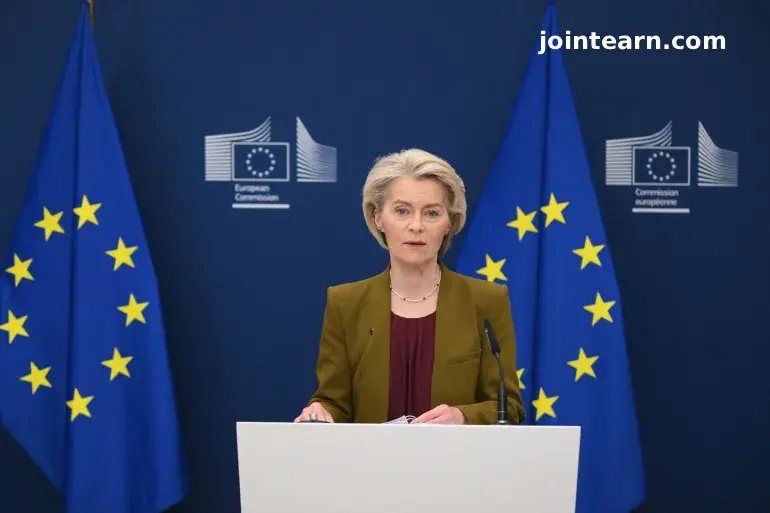
Brussels, Belgium — October 16, 2025:
The European Commission is moving forward with a landmark proposal to build a “drone wall” across its eastern borders, aimed at protecting European Union airspace from Russian drone incursions and other airborne security threats. The project, part of the new European Drone Defence Initiative, represents one of the EU’s most ambitious defence collaborations since the start of Russia’s invasion of Ukraine in 2022.
A Response to Rising Russian Drone Activity
The proposal follows multiple reports of Russian drones violating EU and NATO airspace, including incidents in Poland, Estonia, Denmark, and Germany over the past month. The European Commission’s defence roadmap, released Thursday, outlines a plan for an integrated counter-drone network capable of detecting, tracking, and neutralising hostile unmanned aerial vehicles.
According to draft documents, the anti-drone capabilities are expected to reach initial operational readiness by late 2026 and become fully operational by the end of 2027.
European Commission President Ursula von der Leyen, who has championed the initiative, said Europe “must be ready to defend its skies with European-made technology.”
“It is time for Europe to build a drone wall — a shield that protects our eastern borders and our citizens,” von der Leyen said last month, shortly after 20 Russian drones entered Polish airspace.
Inside the European Drone Defence Initiative
The “drone wall” forms part of a broader strategy known as the European Drone Defence Initiative (EDDI) — a continent-wide web of AI-driven radar systems, jamming technologies, and anti-drone interceptors. The initiative is designed to integrate national defences across EU and NATO members and enable a coordinated response to aerial threats.
The proposal will be presented to:
- Kaja Kallas, EU High Representative for Foreign Affairs and Security Policy
- Henna Virkkunen, European Commission Executive Vice President for Security
- Andrius Kubilius, European Commissioner for Defence
Officials have described the initiative as a “flagship project” for European strategic autonomy, marking a significant step toward reducing reliance on U.S.-made defence systems.
Russian Response and Denials
In Moscow, Russia’s Federal Security Service (FSB) chief dismissed the allegations, accusing NATO intelligence agencies of fabricating drone incursions to “fuel anti-Russian hysteria.” Russian news agency RIA Novosti quoted him as saying Moscow “has no doubt” about NATO’s involvement in creating “incidents” involving unidentified drones over European territory.
The Kremlin has repeatedly denied responsibility for any incursions, calling the claims “provocations aimed at justifying militarisation of Europe’s borders.”
Growing NATO Involvement and Coordination
Meanwhile, NATO has launched a new drone defence mission and strengthened its presence along the eastern flank, particularly in Poland and the Baltic states. NATO Secretary-General Mark Rutte said on Wednesday that the alliance is testing integrated air defence systems that can detect, track, and neutralise drones in real time.
“We are adapting rapidly to the evolving drone threat from Russia,” Rutte said. “NATO and the EU are cooperating closely to ensure European skies remain safe.”
Ukrainian Foreign Minister Andrii Sybiha warned that Russian drone incursions are a deliberate strategy to “test the West’s readiness.”
“Putin is escalating and expanding his war — he’s probing the limits of NATO’s deterrence,” Sybiha said after drone sightings in Poland last month.
However, some European security experts caution that not all incursions may be deliberate. Weather interference, signal disruption, or navigation errors could also explain some drone crossings, they say.
Balancing EU Ambition and NATO Cooperation
While the EU insists that the European Drone Defence Initiative will complement NATO’s work, some member states remain cautious. Critics argue that the project risks duplicating NATO’s air defence responsibilities and may cause friction within the alliance.
EU foreign policy chief Kaja Kallas countered those claims, emphasizing cooperation rather than competition:
“We are not doubling NATO’s work — we are complementing it. Europe must be capable of defending its own skies, but always in coordination with our allies,” Kallas said.
Strategic Autonomy and Europe’s Defence Future
The proposed “drone wall” is part of a broader EU effort to build a more self-reliant European defence architecture, amid fears of waning U.S. commitment to NATO under shifting global politics.
In addition to the drone defence project, Brussels is investing heavily in:
- Next-generation missile defence systems
- European-made drones and surveillance aircraft
- Cybersecurity and counter-electronic warfare infrastructure
The European Defence Fund has already allocated €5.2 billion toward joint projects aimed at reducing dependence on non-EU military suppliers.
Von der Leyen called the initiative a “necessary step toward a stronger, safer, and more sovereign Europe.”
Timeline and Next Steps
The European Drone Defence Initiative will now undergo several rounds of intergovernmental consultations before a final funding package is presented to the European Parliament in early 2026.
If approved, the project could begin deployment across the Baltic states, Poland, Finland, and Romania by mid-2027, covering more than 3,000 kilometers of EU external borders.
European officials hope the system will act as both a deterrent and defensive tool, capable of neutralising drone incursions, surveillance attempts, or hybrid attacks from hostile states.
Leave a Reply